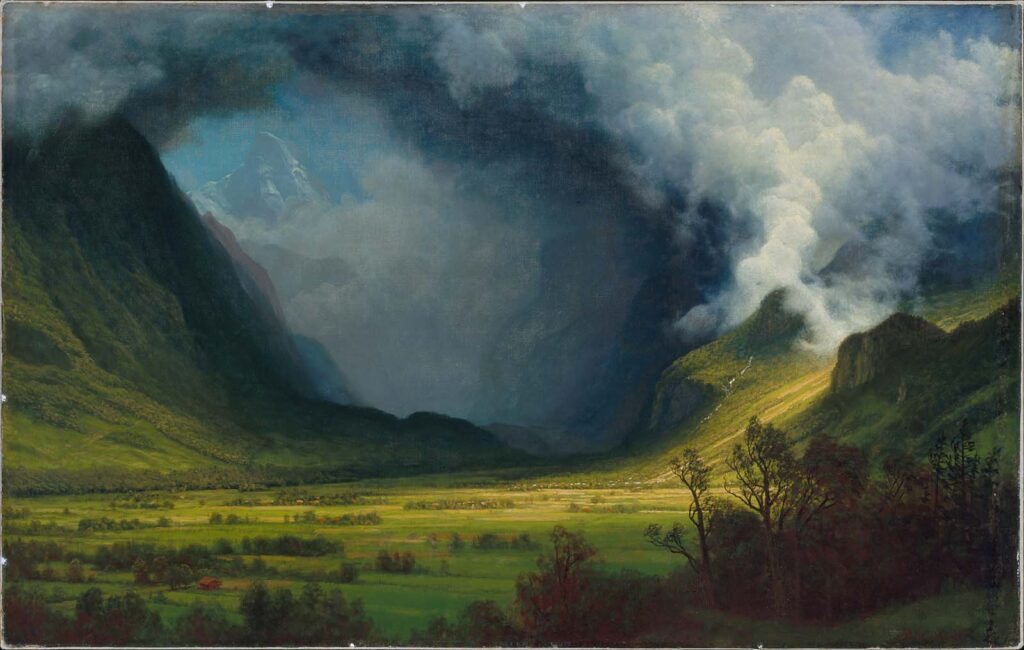
Albert Bierstadt (1830–1902)
The Approaching Storm: White Mountain View with Hay Wagon and Figures, 1861
Oil on canvas
McMullen Museum of Art, Boston College, Carolyn A. and Peter S. Lynch Collection, 2021.18

Jeffery Howe
Professor Emeritus, Art History

Albert Bierstadt was fascinated with the epic grandeur of the American landscape. With his brothers Charles and Edward, he capitalized on the new invention of stereoscopic photography. They opened a photography shop in New Bedford, Massachusetts, in 1859 and in 1860 published a catalogue of photos of the American West and views of the White Mountains of New Hampshire taken from viewpoints chosen by Albert.
The White Mountains were a popular destination in the growing tourist trade, and Bierstadt painted there often, visiting at least seven times between 1852 and 1886. This painting is refreshingly naturalistic, in contrast with some of his earlier works that combined imaginary European castles with the New Hampshire landscape. The heavily loaded hay wagon is returning to the farm, the harvest now secure from being ruined by the rain. The soon-to-be-lost light dances across the canvas, illuminating the hay wagon, workers, and slices of the landscape. Is the approaching storm perhaps a metaphor for the onset of the Civil War? Stormy weather was a fundamental symbol in nineteenth-century literature and art, and Bierstadt was sophisticated in the use of imagery to mirror emotion. His interrogation of reality can be seen here in a double image of the artist pouring himself tea, echoing a similar photo of the French realist Gustave Courbet.

John Sallis
Frederick J. Adelmann, SJ Professor, Philosophy

Nature is the subject of most of Bierstadt’s paintings. A few depict European sites, primarily in the Alps. But most represent scenes in America; the majority of these were painted during Bierstadt’s extensive traveling in the mountainous areas of the West. Many of the mountain paintings are simply entitled “Rocky Mountains,” while others identify their location, for example, Mount Rainier. In addition to the paintings of mountains, there are many others that represent various natural sites. Some show winter scenes, at Yosemite, for example. Others depict rivers such as the Hudson, lakes such as Lake Tahoe, waterfalls as at Niagara, forests such as those in California where the giant redwood trees are located. Storms also figure prominently in many of Bierstadt’s paintings. In Storm in the Mountains (see image), Bierstadt represents the storm as a black mass sweeping across the valley with an off-white cloud suspended above it. The valley is empty of everything human; the landscape is pure nature. On the other hand, in the present work, The Approaching Storm, everything is different. The White Mountains lie in the distance, in contrast to the overpowering presence of the mountains in the other painting. Moreover, the scene is set on a field, an agricultural site, not a valley surrounded by mountains. The remainder of the subtitle identifies the objects in the scene, the hay wagon and figures, presumably the figures of the humans and the horses. The horse and rider on the right side of the picture head away from the approaching storm; another figure leads a child in the same direction, and the hay wagon (with two youths on top) is drawn also in this direction by two white horses. Yet hardly less than in Storm in the Mountains, the storm can be seen raging and threatening. What the painting makes visible is the flight of humans confronted by the force of nature, their flight from the field of their everyday labor, driven in hopes of reaching shelter from the storm.

Noah Snyder
Professor, Earth & Environmental Sciences

Today, the White Mountains in New Hampshire are largely covered by forest (see image). This detailed painting is a reminder that in the mid-nineteenth century most of the land was cleared for agriculture—in this case growing hay in the flat valley and grazing land for sheep on the mountainsides. This is clearly a late summer scene, likely in the Saco River valley. We are lucky that Bierstadt provided such a careful record of a moment in time, because the forces of land conservation and climate change mean that the White Mountain landscape looks different now than it did a century and a half ago. What has not changed are the hard granite and metamorphic rocks that appear as boulders in the foreground and cliff bands in the background.

